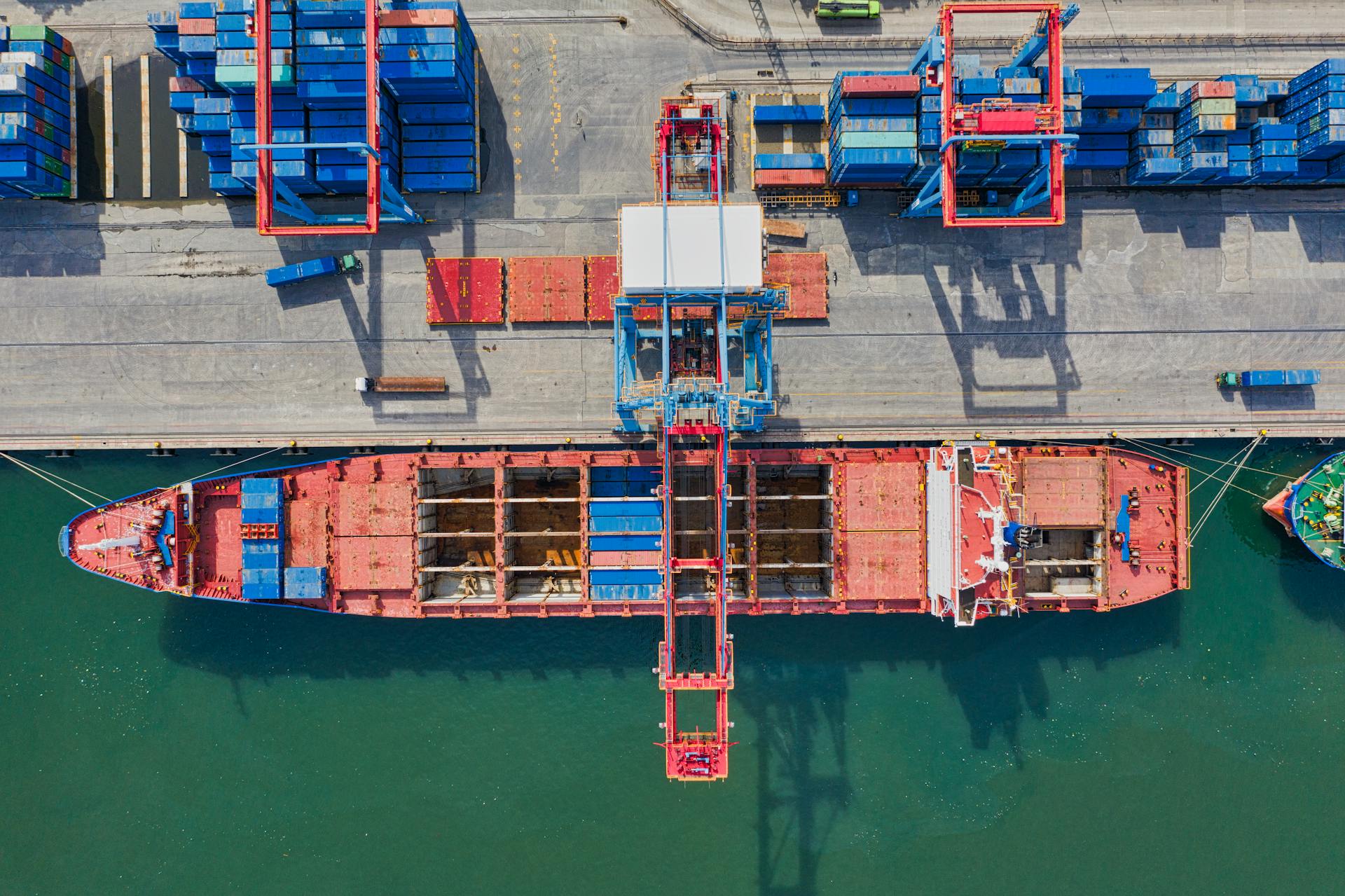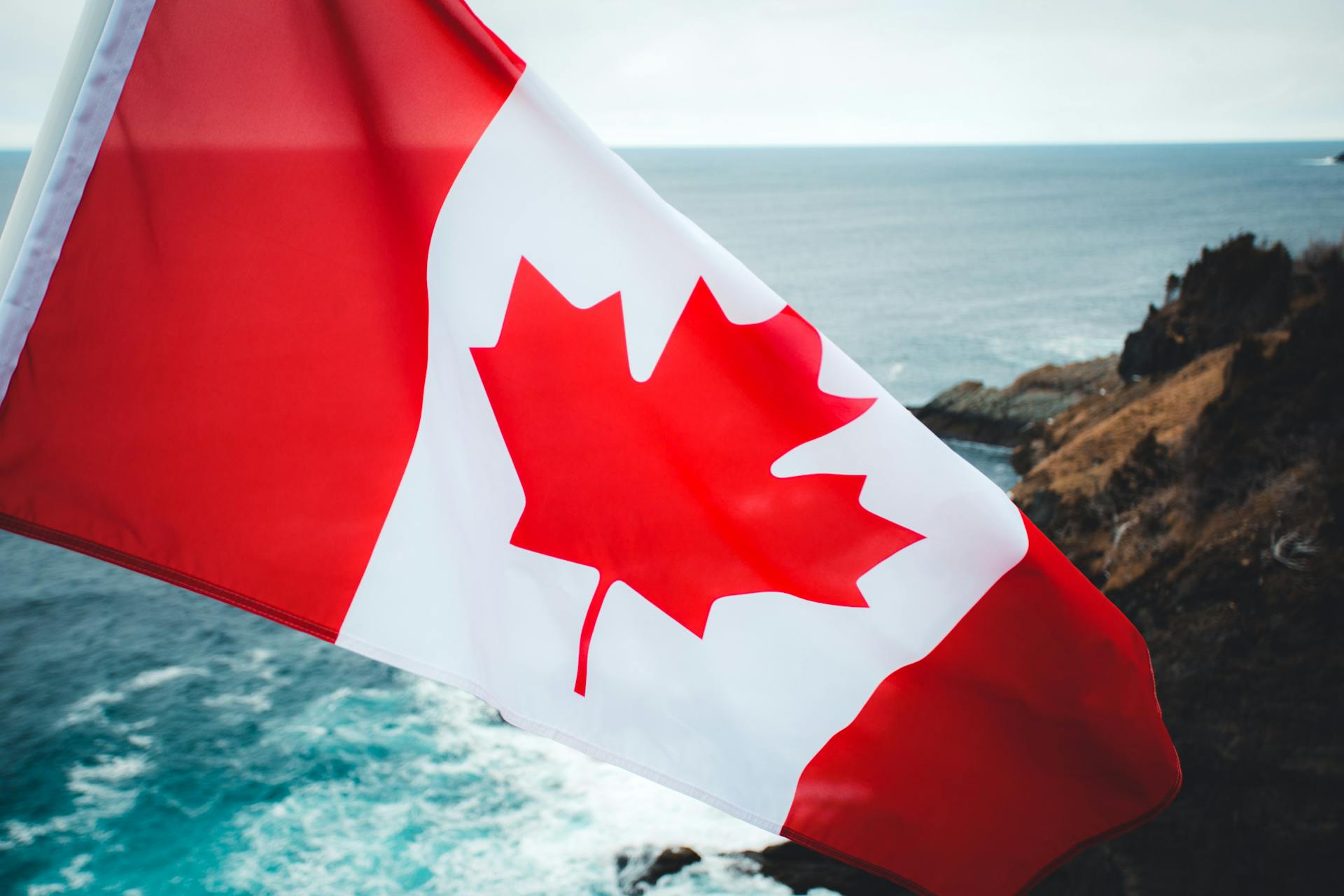
The concept of Free On Board (FOB) shipping point can be a bit confusing, but it's actually quite straightforward. FOB shipping point is a term used in international trade to determine when the buyer takes ownership of the goods.
The FOB shipping point is typically the seller's warehouse or factory where the goods are loaded onto a ship or other mode of transportation. This is the point at which the buyer takes ownership of the goods.
What is FOB Shipping?
FOB shipping is a shipping term that's commonly used in international trade.
It stands for Free on Board, which refers to the point at which the seller transfers ownership of the goods to the buyer.
The seller is responsible for loading the goods onto the ship at the agreed-upon point, and the buyer is responsible for unloading them at the destination.
FOB shipping can take place at various points, such as the factory, a warehouse, or even a port.
The key thing to remember is that the seller's responsibility ends when the goods are loaded onto the ship, and the buyer's responsibility begins.
FOB Shipping Basics
FOB shipping is a crucial aspect of international trade, and understanding its basics is essential for businesses to navigate the process smoothly. FOB stands for Free On Board, which defines the point at which ownership and responsibility for goods are transferred from the seller to the buyer.
The FOB point can be a specific location, such as a port, warehouse, or other designated points. This point is critical in determining who bears the risk and cost of transportation during the shipping process.
Shipping costs are usually tied to FOB status, with shipping paid for by whichever party is responsible for transit. The seller pays transportation and shipping costs to get the goods to the point of origin.
The buyer is responsible for freight costs when dealing with FOB Origin. This means they are accountable for arranging transportation and covering associated expenses.
FOB terms also affect how and when a business will account for goods in its inventory. If a shipment is sent FOB shipping point, the sale is considered complete as soon as the items are with the shipment carrier.
The seller is responsible from the point of pick up and maintaining the goods and transporting them till the delivery point. This includes delivering the goods to a specified location and loading them onto the carrier.
Depending on the FOB terms, the seller or the buyer must pay for the transportation, insurance, customs clearance, and any loss or damage that may occur in transit. FOB also affects the accounting and taxation of the goods, as it defines when the revenue is recognized and who owns the inventory.
The buyer assumes risk once the goods are shipped, and they are responsible for transportation costs if the terms are FOB shipping point.
Incoterms and FOB
Incoterms and FOB are international trade rules established by the International Chamber of Commerce (ICC) that govern the terms of sale for goods in international transactions. There are around a dozen Incoterms, with 11 internationally recognized ones covering buyer and seller responsibilities during exports.
The ICC updates Incoterms periodically, with the last update in 2020, but they remain valid contractual terms. FOB stands for "Free On Board", indicating that the seller is responsible for delivering the goods to a specified port or point of shipment and loading them onto the carrier.
FOB Incoterms mean the seller is responsible for the costs and risks of delivering the goods to the named port or point of shipment, including expenses such as transportation to the port, export clearance, and loading charges.
Incoterms
Incoterms are international commercial terms that govern the terms of sale for goods in international transactions. They are published and maintained by the International Chamber of Commerce (ICC).
There are 11 internationally recognized Incoterms that cover buyer and seller responsibilities during exports. Some Incoterms can be used only for transport via sea, while others can be used for any mode of transportation.
Incoterms were last updated in 2020 but remain valid contractual terms. They can be used in any relevant freight agreement.
FOB Incoterms, which stand for Free On Board, are one of the most commonly used Incoterms for exports by sea. FOB Incoterms are international trade rules established by the ICC that govern the terms of sale for goods in international transactions.
FOB Incoterms mean the seller is responsible for delivering the goods to a specified port or point of shipment and loading them onto the carrier. Once the goods are loaded, the risk and responsibility are transferred from the seller to the buyer.
Incoterms are crucial for effectively managing your business's shipping costs, risks, and responsibilities. The choice between FOB Origin and FOB Destination impacts how logistics are handled, who takes charge of the shipping cost, and at what point the risk of loss or damage to goods transfers from seller to buyer.
The International Chamber of Commerce (ICC) publishes and maintains the Incoterms.
Difference Between CIF
CIF is a preferred method for shipping goods across oceans or through different countries because it ensures efficient and secure movement of goods on a global scale.
CIF includes the cost of insurance in addition to transportation, which means the buyer's responsibility begins after the goods reach the destination.
In contrast, FOB only covers the cost of transportation up to the specified FOB point, leaving the buyer responsible for the goods from that point on.
FreightCenter provides comprehensive international shipping services that support businesses in navigating the intricacies of global trade, including customs clearance, documentation, and freight forwarding.
Their network of reliable carriers and agents can manage every facet of international shipping, ensuring a smooth and secure process.
FreightCenter also offers a range of specialized trucking services, including Less Than Truckload (LTL) and Full Truckload (FTL), to suit diverse shipping needs.
FOB Shipping Costs and Risks
FOB shipping costs and risks can be a bit tricky to navigate, but let's break it down.
The seller is responsible for paying all costs when the terms are FOB destination.
The buyer may still indirectly pay for freight and insurance, even when the seller pays all costs.

In FOB origin, the buyer is responsible for freight costs.
The seller pays transportation and shipping costs to get the goods to the point of origin.
The seller holds the responsibility and risk of shipment at the FOB destination point.
The buyer is responsible for paying the respective fees at the FOB destination point.
The buyer is responsible for the cost of shipping the product to its facility.
FOB price marks where the seller's responsibility ends and the buyer's begins.
The seller is responsible for delivering the goods to the specified location, but the buyer is responsible for paying the freight costs from that point forward.
The seller pays all the shipping costs until the cargo arrives at the buyer’s location.
There are four main variations of FOB terms, including FOB [place of origin], Freight Collect and FOB [place of destination], Freight Prepaid.
FOB Shipping Process and Documentation
At the FOB shipping point, the buyer assumes ownership and responsibility for the goods as soon as they are loaded onto the carrier. This means they bear any risks associated with the goods, such as damage or loss during transit.
The buyer is responsible for paying transportation costs from the shipping point to the final destination, including freight charges, insurance, customs duties, and any other expenses related to transporting the goods.
Documentation and clearance are also the buyer's responsibility, including obtaining necessary permits, paying import duties, and complying with legal requirements.
To ensure smooth FOB shipping, it's essential to clearly state FOB terms in shipping labels, contracts, and other documents. This includes specifying the shipping point or final destination, and detailing responsibilities, such as when the buyer assumes ownership.
Here's a list of essential FOB shipping documents:
- Shipping labels
- Contracts
- Documents specifying the shipping point or final destination
- Documents detailing FOB terms and responsibilities
- Documents showing the date and time of goods transfer and estimated delivery date
- Documents recording the condition of goods at the shipping point and destination
By following these guidelines and documenting FOB shipping terms clearly, both buyers and sellers can avoid potential disputes and ensure a smooth shipping process.
FOB Shipping vs. Other Terms
FOB shipping point is a common shipping term, but it's not the only one. FOB shipping point means the buyer is responsible for transportation costs and assumes risk once the goods are shipped.
The main difference between FOB shipping point and other terms is who is responsible for the shipping costs and risk of loss or damage. With FOB shipping point, the buyer takes on all these responsibilities.
FOB destination, on the other hand, means the seller is responsible for shipping costs and risk until the goods reach the buyer's specified destination. This shifts the burden to the seller.
Freight collect is another term that means the buyer takes on all of the freight charges and risks, including getting insurance and filing a claim if the products are damaged in shipping.
FOB Shipping and Payment
FOB shipping and payment can be a bit confusing, but it's actually quite straightforward. The term 'FOB' (Free On Board) specifies when the responsibility for freight costs and risks transfers from the seller to the buyer.
There are four main variations of FOB terms, but the key thing to know is that FOB shipping points means the seller pays transportation and shipping costs to get the goods to the point of origin. After that, it becomes the buyer's responsibility.
The seller is responsible for delivering the goods to the specified location, but the buyer is responsible for paying the freight costs from that point forward. This is known as FOB [place of origin], Freight Collect.
The seller pays all the shipping costs until the cargo arrives at the buyer's location, which is known as FOB [place of destination], Freight Prepaid. This means the buyer doesn't pay any shipping costs.
FOB Shipping and Contract Law
FOB shipping and contract law are closely related, and understanding the terms is crucial for international trade agreements.
In FOB contracts, the seller is responsible for delivering the goods to a specified location and loading them onto the carrier.
The risk shifts to the buyer once the goods are loaded, who is then responsible for transportation costs and any damage or loss during transit.
FOB in contract law refers to the Free On Board terms commonly used in international trade agreements.
The FOB point can be a specific location, such as a port, warehouse, or other designated points, where ownership and responsibility for goods are transferred from the seller to the buyer.
It indicates who bears the risk and cost of transportation during the shipping process.
FOB does not mean free freight, it designates whether the seller or the buyer is liable for goods damaged during shipping.
If an invoice specifies "FOB shipping point", the buyer is responsible for transportation costs and assumes risk once the goods are shipped.
The buyer assumes ownership and control when the products leave the shipping point, which is where the products are shipped and start their movement toward their final destination.
FOB Shipping Tips and Best Practices
Read all contracts carefully to understand your liabilities under FOB shipping point terms. This will help you avoid unexpected costs and losses.
Calculating potential costs is crucial before agreeing to FOB shipping point terms. Consider all the expenses involved, including transportation and insurance.
Purchase insurance to protect against losses due to damage or theft during transit. This will give you peace of mind and financial security.
Negotiate additional terms in your shipping or sales agreement to protect yourself against losses. This may include clauses for damage or non-delivery.
Consider the importance of reading shipping labels carefully, especially when receiving items under FOB shipping point terms.
Sources
- https://www.shopify.com/blog/what-is-fob-shipping-point
- https://www.freightcenter.com/answers/free-on-board-fob/
- https://www.accountingtools.com/articles/fob-shipping-point
- https://www.saasant.com/blog/fob-shipping-a-detailed-walk-through/
- https://www.unishippers.com/shipping-resources/freight-resources/free-on-board-shipping
Featured Images: pexels.com


